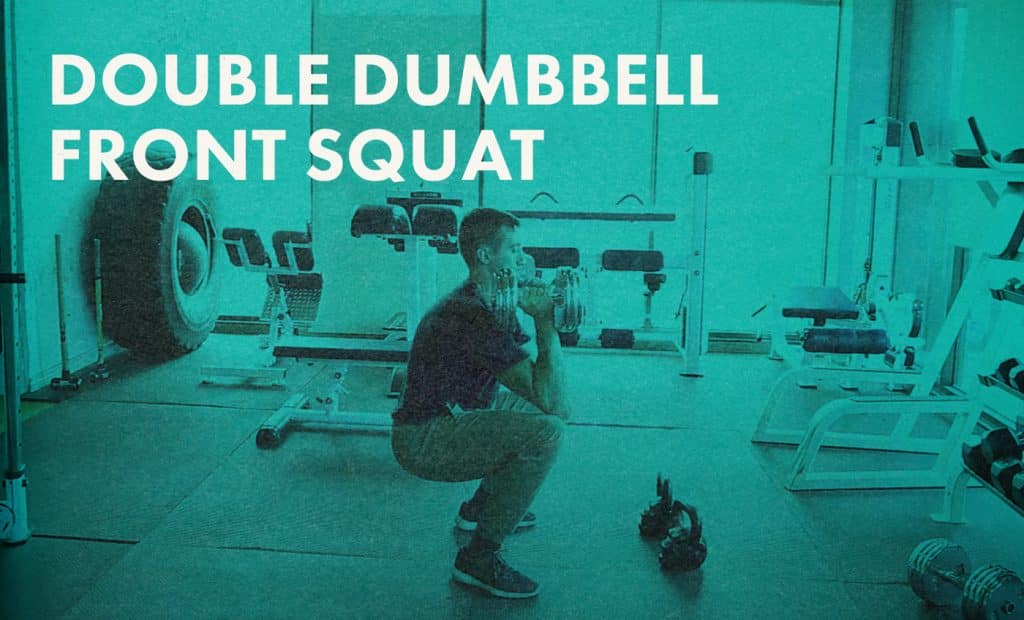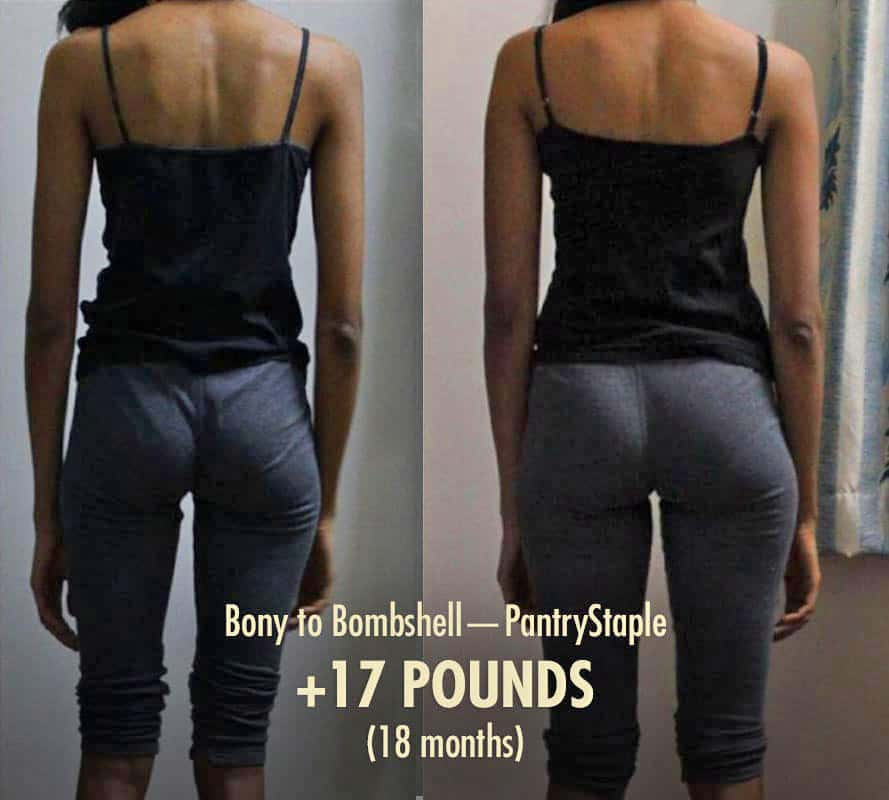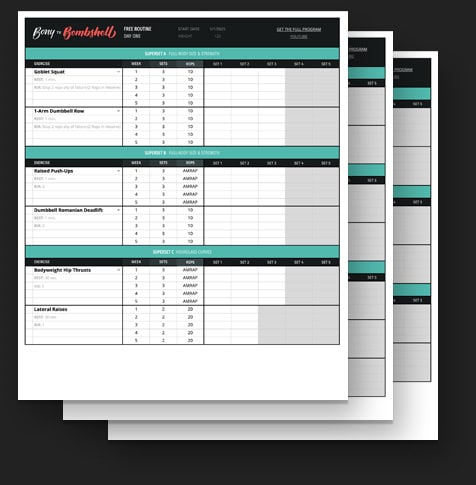
Double Dumbbell Front Squat: How To Do It Properly & Tips
The double dumbbell front squat is a great variation for women ready to progress past the dumbbell Goblet Squat. It’s a great choice because while it hits the quads and glutes, it’s also a full-body exercise that hits the anterior core, upper back, and shoulders as you stabilize the dumbbells on your shoulders. The double dumbbell front squat will help to develop not only an attractive female body but an athletic one, too. Let’s take a closer look:
Double Dumbbell Front Squat: The Overview
Muscles Worked
The double dumbbell front squat is a full-body compound lift that works these muscles in order of importance:
- the quads (front of thighs)
- the glutes
- entire posterior chain (the back side of your body)
- postural muscles such as the spinal erectors and front (anterior) core (abs, obliques, etc.)
- upper back and shoulders (to stabilize the dumbbells)

Double Dumbbell Front Squat Video Demonstration
The key to this exercise is making sure that you’ve got the dumbbells in a sturdy position and that your posture is tall. Here’s Bony to Bombshell coach Marco demonstrating how to do the double dumbbell front squat with proper form:
Double Dumbbell Front Squat Proper Form Breakdown:
- First, grab two dumbbells that you can handle well.
- Go to a space where you can do the full movement without hitting anything.
- Swing the two dumbbells up into position, resting near your shoulders, with your elbows up.
- Your stance should be shoulder width, with your toes pointed out a bit.
- Get tall, take a deep breath, and start the descent.
- Go as deep as you can in the range of motion you have. (Don’t force ROM that you don’t have. If you do this, your lower back will start to bend and tuck downwards, called a butt wink, causing a sore back.)
- At the bottom of the movement, press through your whole foot, sometimes called the tripod foot (heel, ball of big toe, base of little toe) and stand back up.
- Breathe out as you push.
- That’s one rep. Do as many reps as it says on your workout programming.
- When you’ve finished your set, pop the weights off and let them swing down and between your legs to absorb their momentum (sort of like a kettlebell swing) if needed. Place the dumbbells on the floor.
Common Double Dumbbell Front Squat Mistakes
- Doing High-Reps. While you can build muscle in the 4-40 rep range, this lift is best used with a medium rep range, in the 5-10 rep range. If you start doing high reps because it’s challenging for the upper body and shoulders, you’ll find that your elbows start to drop over time, and it can make the exercise more dangerous (because you’ll need to dump the dumbbells.)
- Setting Up The Stance Wrong. You don’t want to stand super-wide or super narrow stance. Shoulder width is ideal, with the toes pointed slightly out.
- Choosing Too Heavy Of A Weight. Luckily, no one cares how much you can double dumbbell front squat, so this isn’t really an ego lift. But lifting too heavy can still happen. When someone picks too heavy of dumbbells, chances are they’re not going to do the whole range of motion that they could have. Because the weight is in front, you can squat more deeply. That’s one of the main advantages. So don’t shortchange that benefit by choosing a weight so heavy you can’t squat the whole way down. So lighten the dumbbells, and choose a weight that you can all the reps with pristine form.
Using The Double Dumbbell Front Squat In A Workout
Use A Small To Moderate Rep Range
In research, to optimize for muscle growth and muscle size, you want to choose a weight that you can do 4–40 repetitions with. However, with the double dumbbell front squat, it’s better to stay in the smaller rep range due to getting tired in the upper body. The best range seems to be in the 5-10 rep range.
If you find yourself not able to do 5 reps, use a lighter weight. If you can do more than 12 repetitions, use a heavier weight. That will guarantee that the workout is helping you gain both muscle size and muscle strength and not making endurance adaptations.
Challenge Yourself, But Stop Shy Of Failure
Ideally, you’ll stop your set when you’re just about to fail and have a rep or two left in you. But if you’re a beginner, it’s hard to know exactly how hard you’re pushing yourself. Normally, we recommend exploring what failure feels like, but because squats are heavy compound lifts and they involve your spine, it’s not the best idea for beginners to do this. Err on the side of lifting too light, and if it’s too light, count it as a warm-up. Keep working up, and you’ll know when the weight is right for your goal reps.
Start With Two Sets, and Add More When Needed
Start with just a couple of sets, then over time, add more sets as you get stronger. We recommend doing two sets in the first week. Practice your form, find the right weights, and take your time learning the movement.
Next week, if you aren’t too sore at the start of each workout, try adding a set to each exercise. If that goes well and you feel ready for more, add another set next week. You can do around 3–6 sets per exercise. Most people will do best with 3–4 sets. If you ever start to feel worn down, or if you’re coming back after a long break, start the cycle over again, going back to just two sets per exercise and rebuilding from there.
Rest 2-3 Minutes Between Sets
How long you rest between sets of squats isn’t that important. Whether you rest for 2 minutes or 10 minutes, you’ll still stimulate a similar amount of muscle growth. The important thing is that you rest long enough to catch your breath, ensuring that your cardiovascular system doesn’t limit the performance of your muscles. We want to challenge your leg muscles, not just your heart (though your heart will get a good workout, too!).
The main reason to rest for just a couple of minutes is to keep your workouts shorter. You don’t want to spend all day in the gym. But if you need more rest or get interrupted partway through your workout, no problem. Just pick up where you left off.
If you want to blast through your workout even faster, you can do the lifts in a circuit/superset. Do a set of 2-db front squats, rest a minute, then do a set of raised push-ups, rest a minute, then do your second set of 2-db front squats, and then do your second set of raised push-ups. That way, you’re still giving different muscle groups plenty of time to recover between sets, but you’re doing another exercise during the rest period.
Free Routine For Female Beginners: The Double Dumbbell Front Squat With Full Body Workout
If you don’t have a workout, you might be interested in our full Bony to Bombshell program. A sample beginner’s workout for women, with some priority given to the double dumbbell front squats (doing the exercise first), could look like this:
- Double Dumbbell Front Squats: 2 sets of 7 repetitions.
- Raised Push-Ups: 2 sets of as many reps as you can.
- Dumbbell Romanian Deadlift: 2 sets of 10 repetitions.
- 1-Arm Dumbbell Row: 2 sets of 10 repetitions.
- Lateral Raises: 2 sets of 10 repetitions.
- Bonus Glute Work: 2 sets of glute bridges or hip thrusts
GET THE GOOGLE SPREADSHEET OF THE
FREE BEGINNER’S FULL-BODY WORKOUT For Women

Get the workout as a Google spreadsheet. You’ll be able to pick from exercise alternatives, fill out the sheet, and get our beginner’s warm-up.
Plus, we’ll make sure you’re on the Bony to Bombshell newsletter, and send you all of our best women's muscle-building content.
Frequently Asked Questions About The Double Dumbbell Front Squats
Here are some of the most common questions we’ve gotten from women about the two dumbbell front squats:
Q: For the double dumbbell front squat, how heavy should I lift with?
A: That depends on your own starting point. It is better to do trial and error with too light of weight than to throw on something too heavy and struggle and put yourself at risk of injury. Don’t let your ego choose. Pick a weight you can handle properly. Start light, and if that feels too easy, then you can start adding some weight to the bar. Remember, ease into weight. Add a little bit, test it out. If it feels too easy, that’s another warm-up set.
Q: How often should I double dumbbell front squat?
A: That depends on your goals, but we’re also big fans of this lift, so it’s one we include in the Bombshell programming a lot, so we might be a bit biased. If you want to master it, you can do this one a couple of times throughout the week. Because this lift is heavier and is a full-body compound lift, it can exhaust some of your stabilizer muscles. This is great for getting an athletic body that looks balanced, but it can also take the power out of some of your other lifts because you’re a bit fatigued. So pay attention to how you’re feeling. If you’re dreading the idea of working out, you may be doing this one too much.
If your goal is just to get the general quad and glute growth, you’ll want to pair that exercise with other lower-body exercises for balanced growth. Think of things like dumbbell Romanian deadlifts and glute bridges.
Q: Can I do the double dumbbell front squat at home?
A: For sure. In fact, this double dumbbell front squat variation is usually chosen because someone only has access to dumbbells when working out at home and doesn’t have a barbell for the barbell front squat.
Q: How can I modify the double dumbbell front squat? What are some variations?
A: The first and best variation would be the dumbbell goblet squat. When one dumbbell is too easy for you (or you can no longer hold up a single heavy dumbbell very well), you can graduate to this variation: the double dumbbell front squat. Now, you can put the weight up on your shoulders and continue to lift heavy and remove your grip from the equation. When this variation gets too easy, then you can graduate to the barbell front squat.
What Next?
Add some barbell front squats into your lifting routine, and your quads, glutes, and general posture will be thanking you. If you liked this article, you’d love our muscle-building newsletter. We’ll keep you updated on all the latest muscle-building information for women. Or, if you want us to walk you through the process of building muscle, including teaching you the lifts, giving you a full workout program, a complete diet guide, a recipe book, and online coaching, check out our Bony to Bombshell Program.



FREE women's Muscle Growth MINI-COURSE
Get our 5-part female bulking mini-course that covers everything you need to know about:
Here are some related articles